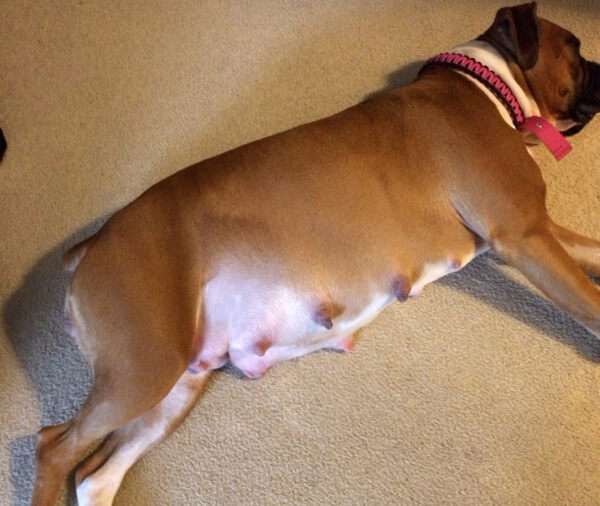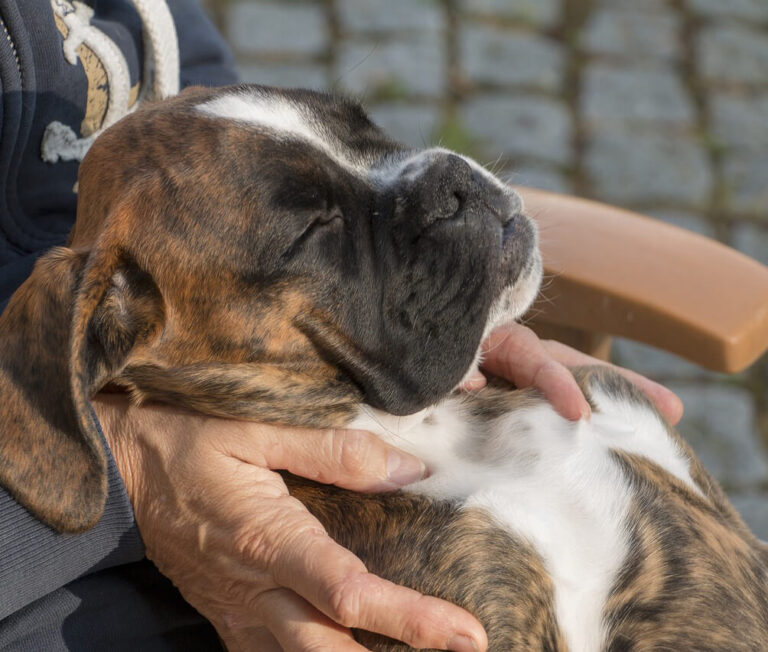Boxer Pregnancy: A Comprehensive Guide for Boxer Dog Pregnancy
If you own a female boxer or plan on breeding boxers in the future, it’s crucial to understand what happens during boxer pregnancy. Proper care during this time is essential for the health of both mother and puppies.
Table of Contents
ToggleUnderstanding what to expect during boxer pregnancy, labor, and delivery will help you see any potential issues or complications earlier. Knowing the procedure will assist guarantee that the puppies have the best possible start in life in addition to giving your pregnant dog the care they need.
Anyone who owns a boxer or intends to breed one in the future will benefit from understanding the breed, but understanding boxer pregnancy is even more crucial. The process may be lovely and satisfying if you give it the necessary care and attention, which will benefit both you and your furry pet.

Boxer Pregnancy: What to Expect
Gestation period and length of Boxer Pregnancy
Boxer dog gestation lasts, on average, 63 days, but it can be anywhere between 59 and 67 days. The mother boxer’s body goes through a lot of changes during this time to support and feed the developing puppies.
It is crucial to remember that every pregnancy is different, and the gestational period can differ depending on a number of variables, including the size of the litter and the health of the mother. It’s possible that the mother boxer doesn’t have any physical changes during the first few weeks of boxer pregnancy.
Her nipples could expand and turn more pinkish by week four or five, though. She might put on weight by week six or seven and start to exhibit a protruding belly as the puppies grow.
To get exact date of your boxer pregnancy use the calculator
Physical changes in the mother boxer
There will be more physical changes in the mother boxer’s body as the Boxer pregnancy goes on. Due to her body working more than usual to sustain both herself and her developing puppies, she could experience increased hunger and thirst. As the due date for the puppies draws nearer, her belly will keep growing.
Other bodily changes that could take place include exhaustion, a drop in activity, and sporadic nausea or vomiting. Owners should keep a close eye on their pregnant Boxer’s general health during this period by scheduling routine veterinary visits.

Behavioral changes in the mother during boxer pregnancy

Preparing for Boxer Pregnancy
Choosing a reputable breeder or rescue organization
Selecting a reputable breeder or rescue group is crucial if you intend to breed your boxer. A responsible breeder will look out for the dog’s best interests and make sure they are healthy and well-cared for. Consider a breeder’s credentials, references, experience, and any certifications they may have while making your decision.
If you want to adopt a pregnant boxer from a rescue group, be sure to enquire about the dog’s health history and any possible pregnancy-related hazards. Additionally, make sure the rescue group has experience caring for pregnant dogs and is a reputable one.
Ensuring the mother boxer is healthy and up-to-date on vaccinations
Have your boxer examined by a vet to make sure she is in good enough condition for pregnancy before breeding her. If necessary, the veterinarian may advise more shots or boosters. Your dog must have the right nourishment throughout her pregnancy, so talk to your veterinarian about the best diet to give her during this time.
Additionally, it’s crucial to treat any pre-existing conditions like diabetes or thyroid issues that could otherwise have a negative impact on the health of both the mother and the puppies. Before breeding even starts, you can avoid future problems by paying attention to these aspects.
Creating a comfortable and safe environment for the mother and puppies
For her body to be in shape for labor later on, your boxer must have access to lots of food (ideally high-quality puppy chow), water (which should always be available), and adequate exercise. By providing cozy bedding in every area where she enjoys spending time, designating one room exclusively for whelping, and offering plenty of toys and stimulation throughout pregnancy to keep her engaged and content, you may assist establish an atmosphere that is supportive of these requirements. Your boxer will require a warm, calm, and clean environment to give birth and suckle the puppies throughout labor.
Make sure that the whelping box is big enough for both mother and puppies – but not too big; it should be easy for the mother to keep all of her pups in one area so they can stay warm together. By making sure she has everything she needs for a comfortable pregnancy in advance, you can remove some of the stress from this exciting time!
Signs of pregnancy in Boxers/Boxer Labor and Delivery
Signs that Labor is Approaching
Usually, boxer dogs give birth 58 to 65 days after ovulation. You might observe certain adjustments in your dog’s body and behavior as labor draws near.
The mother boxer may start to pace, pant, or scratch at her bedding as her agitation increases. An rise in body temperature (over 101 degrees Fahrenheit), loss of appetite, nesting activities like digging or rearrangement of bedding, and a thicker discharge from the vulva are other indicators that labor is about to start.
Stages of Labor during boxer pregnancy
There are three stages of labor for a boxer dog:
Early labor, active labor, and puppy delivery. Early labor can last anywhere between 6 and 12 hours without being apparent to the owner.
The cervix starts to enlarge during this phase as contractions intensify. For first-time mothers, active labor can take up to 24 hours and often lasts between 2 and 4 hours.
At this point, the contractions are so intense that puppies are delivered once or twice per hour or so. The mother boxer will probably vocalize when giving birth, but she should generally keep her composure.
When all puppies have been delivered, which usually occurs a few hours after active labor ends, is when the stage is complete. As the mother delivers the new litter and starts nursing them, she will continue to have light contractions.
Caring for Newborn Puppies
All puppies who are born with their sacs ruptured (or by the mother) require immediate medical attention. For newborn puppies to thrive, they require care, food, and excitement. Within a few hours of giving birth, the mother boxer should start nursing the puppies and will naturally start licking them clean.
Each puppy needs to have enough nursing time, and daily weight monitoring is crucial. As she needs extra nutrition during this time, make sure the mother has access to plenty of fresh water and foods high in protein.

Potential Complications During Boxer Pregnancy
Eclampsia (Milk Fever)
Dystocia (Difficult Labor)
Mastitis (Inflammation of Mammary Glands)
Frequently Asked Questions
A boxer pregnancy lasts for about 63 days.
The first signs of pregnancy in a boxer will typically appear around 2-3 weeks after breeding. These signs may include:
- Increased appetite
- Weight gain
- Lethargy
- Swollen nipples
- Changes in behavior, such as becoming more clingy or affectionate
A pregnant boxer needs a high-quality, nutritious diet. A good food for a pregnant boxer will be high in protein and fat, and low in carbohydrates.
A pregnant boxer should get moderate exercise. Too much exercise can be harmful to the puppies, but too little exercise can lead to weight gain and other health problems.
There are some risks associated with breeding boxers, such as:
- Dystocia: This is a condition in which the puppies are difficult to deliver.
- C-section: This is a surgical procedure that is sometimes necessary to deliver the puppies.
- Stillbirth: This is when a puppy dies before or during birth.
There are also some benefits to breeding boxers, such as:
- The puppies can be sold or given away to loving homes.
- The puppies can be used for showing or breeding.
- The puppies can be used as therapy dogs.
he average litter size for a boxer is 5-7 puppies. However, the number of puppies in a litter can vary greatly, and some boxers have had litters as large as 14 puppies. The number of puppies in a litter is determined by a number of factors, including the size of the mother dog, the health of the mother dog, and the number of puppies that were conceived.
Week 1
The first week of pregnancy is often difficult to detect, as there are no visible signs. However, the mother dog may start to exhibit some behavioral changes, such as increased appetite and clinginess.
Week 2
By the second week of pregnancy, the mother dog’s uterus will start to enlarge. She may also start to gain weight.
Week 3
By the third week of pregnancy, the mother dog’s puppies will start to develop their bones and muscles. She may also start to produce milk.
Week 4
By the fourth week of pregnancy, the mother dog’s puppies will start to develop their fur and teeth. She may also start to feel the puppies moving around inside her.
Week 5
By the fifth week of pregnancy, the mother dog’s puppies will be fully formed. She may start to slow down her activity level and may become more irritable.
Week 6
By the sixth week of pregnancy, the mother dog’s puppies will be about the size of walnuts. She may start to build a nest in preparation for the birth of her puppies.
Week 7
By the seventh week of pregnancy, the mother dog’s puppies will be about the size of lemons. She may start to lose her appetite and may become restless.
Week 8
By the eighth week of pregnancy, the mother dog’s puppies will be about the size of grapefruits. She may start to produce colostrum, which is the first milk that her puppies will drink.
Week 9
By the ninth week of pregnancy, the mother dog’s puppies will be about the size of softballs. She may start to show signs of nesting, such as digging or rearranging her bedding.
Week 10
By the tenth week of pregnancy, the mother dog’s puppies will be fully developed and ready to be born. She may start to go into labor at any time.

